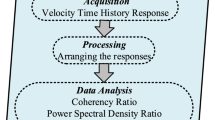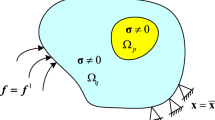Abstract
In this study, a novel two-stage approach for damage detection of determinate truss structures is proposed. The method lies in the group of vibration-based methods but it just needs the first natural frequency and mode shape vector of these structures for identifying the location and severity of damage. In the first stage, the modal residual force vector for different modes of a structure is introduced and the one associated with the first mode is applied to the structure as an external nodal force vector. Then, the residual local nodal force vector can be computed for all elements of the structure. Next, the elements with non-zero residual internal force are considered as damaged elements. In the second stage, the damage severity of each damaged element is determined using a new relation which can be categorized as a force–displacement relation. To show the efficiency and simplicity of the proposed method, three truss structures including a 13-bar planar truss, a 29-bar planar truss, and a 77-bar planar truss under different damage scenarios are studied; the results of which indicate that the method is innovatively capable of suitably detecting, for determinate truss structures, not only damaged members but also their individual damage severity by carrying solely one analysis.









Similar content being viewed by others
References
Hao H, Xia Y (2002) Vibration-based damage detection of structures by genetic algorithm. J Comput Civ Eng 16(3):222–229
Perera R, Torres R (2006) Structural damage detection via modal data with genetic algorithms. J Struct Eng 132(9):1491–1501
Sandesh S, Shankar K (2010) Application of a hybrid of particle swarm and genetic algorithm for structural damage detection. Inverse Probl Sci Eng 18(7):997–1021
Meruane V, Heylen W (2011) An hybrid real genetic algorithm to detect structural damage using modal properties. Mech Syst Signal Process 25(5):1559–1573
Kang F, Li J-J, Xu Q (2012) Damage detection based on improved particle swarm optimization using vibration data. Appl Soft Comput 12(8):2329–2335
Nobahari M, Ghasemi MR, Shabakhty N (2017) A novel heuristic search algorithm for optimization with application to structural damage identification. Smart Struct Syst 19(4):449–461
Nobahari M, Seyedpoor SM (2011) Structural damage detection using an efficient correlation-based index and a modified genetic algorithm. Math Comput Mode 53(9):1798–1809
Gomes GF, da Cunha SS, Ancelotti AC (2018) A sunflower optimization (SFO) algorithm applied to damage identification on laminated composite plates. Eng Comput 1–8
Guo HY, Li ZL (2009) A two-stage method to identify structural damage sites and extents by using evidence theory and micro-search genetic algorithm. Mech Syst Signal Process 23(3):769–782
Yun GJ et al (2009) A two-stage damage detection approach based on subset selection and genetic algorithms. Smart Struct and Syst 5(1):1–21
Cury AA, Borges CCH, Barbosa FS (2010) A two-step technique for damage assessment using numerical and experimental vibration data. Struct Health Monit 10(4):417–428
Jiang S-F, Zhang C-M, Zhang S (2011) Two-stage structural damage detection using fuzzy neural networks and data fusion techniques. Expert Syst Appl 38(1):511–519
Seyedpoor SM (2012) A two stage method for structural damage detection using a modal strain energy based index and particle swarm optimization. Int J Non-Linear Mech 47(1):1–8
Xiang J, Liang M (2012) A two-step approach to multi-damage detection for plate structures. Eng Fract Mech 91:73–86
Seyedpoor SM, Montazer M (2016) A two-stage damage detection method for truss structures using a modal residual vector based indicator and differential evolution algorithm. Smart Struct Syst 17(2):347–361
Nobahari M, Ghasemi MR, Shabakhty N (2017) Truss structure damage identification using residual force vector and genetic algorithm. Steel Compos Struct 25(4):485–496
Nobahari M, Seyedpoor SM (2013) An efficient method for structural damage localization based on the concepts of flexibility matrix and strain energy of a structure. Struct Eng Mech 46(2):231–244
Ghasemi MR, Nobahari M, Shabakhty N (2018) Enhanced optimization-based structural damage detection method using modal strain energy and modal frequencies. Eng Comput 34(3):637–647
Nobahari M, Ghasemi MR, Shabakhty N (2018) A fast and robust method for damage detection of truss structures. Appl Math Model 2018.
Ghiasi R, Fathnejat H, Torkzadeh P (2018 A three-stage damage detection method for large-scale space structures using forward substructuring approach and enhanced bat optimization algorithm. Eng Comput 1–18
Mares C, Surace C (1996) An application of genetic algorithms to identify damage in elastic structures. J Sound Vib 195(2):195–215
Rao SS. 9-analysis of Trusses, Beams, and Frames. In: Rao SS (ed) The finite element method in engineering (Fourth Edition). Butterworth-Heinemann, Burlington, pp 309–356
Author information
Authors and Affiliations
Corresponding author
Additional information
Publisher's Note
Springer Nature remains neutral with regard to jurisdictional claims in published maps and institutional affiliations.
Rights and permissions
About this article
Cite this article
Naderi, A., Sohrabi, M.R., Ghasemi, M.R. et al. A swift technique for damage detection of determinate truss structures. Engineering with Computers 37, 2183–2191 (2021). https://doi.org/10.1007/s00366-020-00940-0
Received:
Accepted:
Published:
Issue Date:
DOI: https://doi.org/10.1007/s00366-020-00940-0




